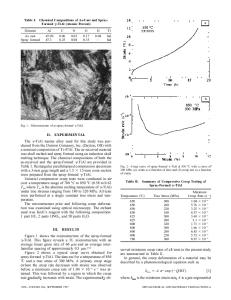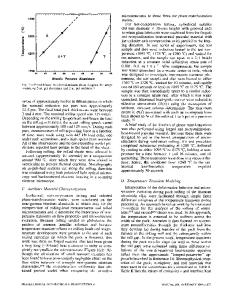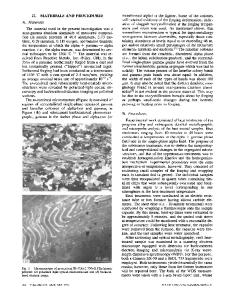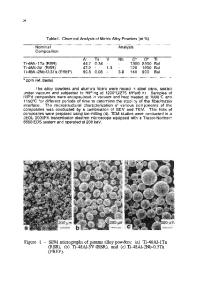Plastic-flow behavior and microstructural development in a cast alpha-two titanium aluminide
- PDF / 4,142,730 Bytes
- 11 Pages / 613 x 788.28 pts Page_size
- 2 Downloads / 296 Views
I.
INTRODUCTION
I N the area of metalworking, considerable attention has been focused over the last 30 years on processingmicrostructure relationships for wrought starting materials. The final microstructure developed in advanced alloys often depends strongly upon the processing parameters used in each of the unit processes which comprise the overall manufacturing sequence. However, processing-microstructure relationships for cast starting materials have generally been ignored in the past, and efforts are currently being undertaken to fill this void. Because of the large commercial tonnages involved, the breakdown of cast ferrous products has received the majority of attention in the technical literature, albeit to a limited extent as compared to the investigation of thermomechanical processing of wrought materials. Examples of studies on such materials include those of Decroix et al. m and Torkhov et al. I21 on the breakdown of ferritic and high-nitrogen stainless steels, respectively. With the advent of continuous casting of thick and thin slabs in the steel industry, modification of rolling practice to produce uniform recrystallized structures in such products is of increasing interest, t31 A few investigations of the workability of cast nonferrous materials have also been reported in the litera-
S.L. SEMIATIN, formerly Senior Research Scientist, Metalworking Group, Battelle Memorial Institute, Columbus, OH 43201, is Senior Scientist, Materials Directorate, Wright Laboratory, WL/MLLN, Wright-Patterson Air Force Base, OH 45433. K.A. LARK, Materials Engineer, is with the Materials Directorate, Wright Laboratory, WrightPatterson Air Force Base. D.R. BARKER and V. SEETHARAMAN, Senior Scientists, are with the Processing Science Division, Universal Energy Systems, Dayton, OH 45432. B. MARQUARDT, Lead Engineer, is with Advanced Materials Development, GE Aircraft Engines, General Electric Company, Cincinnati, OH 45215. Manuscript submitted February 12, 1991. METALLURGICAL TRANSACTIONS A
t u r e , [4"5'6] including development of breakdown practices
for nickel-, titanium-, and aluminum-base alloys. Deformation processing of titanium alloys is of considerable interest in view of their low-density and hightemperature capabilities. Because of the difficulty in controlling interstitial levels in powder metallurgy (PM) consolidated titanium alloys and the expense associated with PM processing, conventional mill processing of these alloys usually incorporates ingot casting, followed by an extensive amount of hot working to ensure complete removal of the cast structure. Moreover, in view of the dearth of detailed information regarding the effects of strain, strain rate, and temperature upon recrystallization, mill breakdown of titanium alloys typically includes a large amount of redundant work and practices which have evolved largely by trial and error over the years. Ordered intermetallic titanium alloys such as those based upon the Ti3AI (c~2) and TiA1 ('y) phases are of great interest because of their substantially high
Data Loading...











